Your fitness watch monitors stress recovery by analyzing heart rate variability (HRV), which measures tiny variations between heartbeats that reflect your autonomic nervous system’s activity. Advanced biosensors use multiple light wavelengths to capture cardiovascular data, while machine learning algorithms process this information alongside skin temperature and movement patterns. The watch creates personalized stress scores by comparing your real-time physiological data to your baseline patterns. Continuous monitoring provides immediate feedback, helping you optimize recovery and performance through deeper insights into your body’s stress response mechanisms.
The Science Behind Stress Recovery Monitoring in Fitness Watches
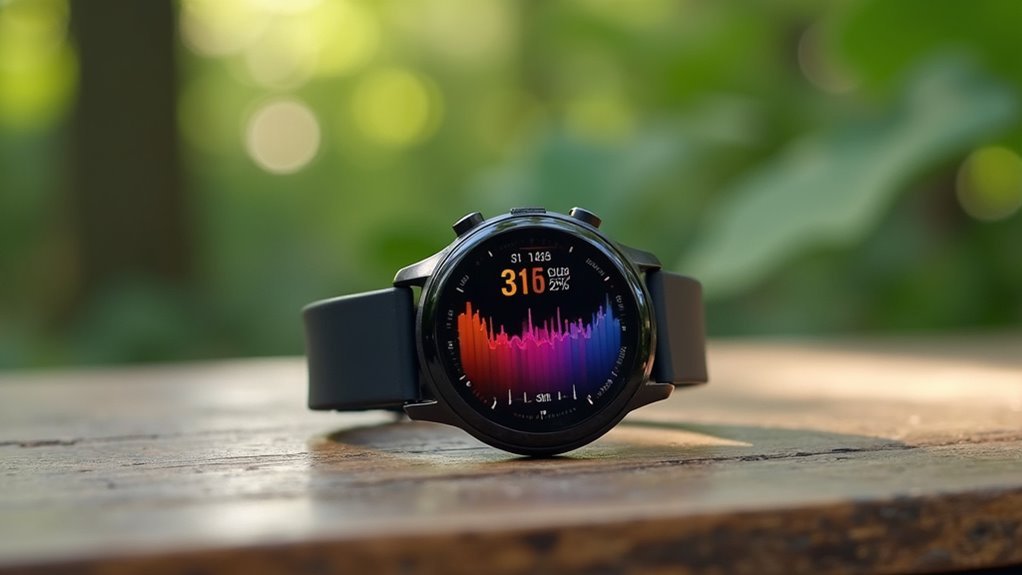
While stress has long been considered an invisible health factor, modern fitness watches now transform this intangible experience into measurable data through sophisticated monitoring systems.
Your device uses advanced biosensors to continuously monitor physiological changes like heart rate variability, body temperature, and oxygen levels. Complex algorithms analyze these metrics alongside your physical activity patterns to distinguish between exercise-induced changes and actual stress responses.
The technology employs multi-parameter analysis, examining not just your heart rate but also sleep patterns and temperature fluctuations. This all-encompassing approach creates stress scoring systems that provide you with quantifiable measurements.
Your watch tracks historical trends over time, helping you identify recurring stress patterns and develop targeted recovery strategies through real-time feedback and personalized insights. Modern fitness watches also provide training readiness features that assess your recovery time and help determine when your body is prepared for the next workout session.
Heart Rate Variability as the Primary Stress Assessment Metric
Your fitness watch doesn’t just count heartbeats—it analyzes the tiny variations between each beat to assess your stress levels through heart rate variability (HRV).
When you’re stressed, your sympathetic nervous system kicks in and reduces these natural variations, while relaxation increases them through parasympathetic activity.
The device’s algorithms process this real-time HRV data using metrics like RMSSD and LF/HF ratios to give you immediate insights into your body’s stress response and recovery state. While chest strap monitors typically deliver superior accuracy compared to wrist-based devices for HRV measurements, modern fitness watches continue advancing their sensor technology.
HRV Measurement Fundamentals
When your heart beats, the time between each beat isn’t perfectly uniform—this natural variation forms the foundation of heart rate variability (HRV), your body’s most revealing indicator of stress and recovery.
Your fitness watch measures these RR intervals in milliseconds using continuous heart rate monitoring, capturing the precise timing between consecutive heartbeats through electrocardiogram technology.
The device calculates RMSSD (Root Mean Square of Successive Differences), emphasizing short-term recovery patterns that reflect your autonomic nervous system’s balance.
Specialized software transforms this raw data into numerical values and visual representations you can understand.
Your watch analyzes HRV through both time domain metrics, like standard deviation of RR intervals, and frequency domain analysis using Fast Fourier Transformation for thorough spectral assessment of your physiological state. High HRV indicates your body’s adaptability and resilience, showing greater capacity to handle stress and maintain optimal health.
Stress Detection Algorithms
Because your fitness watch relies on complex algorithms to transform raw HRV data into meaningful stress assessments, it processes multiple physiological signals simultaneously through sophisticated machine learning pipelines.
Your device extracts features like SDNN and RMSSD from HRV intervals, combining them with electrodermal activity and skin temperature readings. The algorithm uses mutual information techniques to select the most relevant features from 20+ physiological parameters, creating thorough feature vectors for analysis.
Your watch’s machine learning classifiers, such as SVM or Random Forest models, categorize your stress states in real-time. The system adapts dynamically, setting personalized thresholds based on your unique data patterns. These algorithms eliminate the subjective bias that affects traditional stress assessment questionnaires and interviews.
Through continuous monitoring and validation against clinical benchmarks, these algorithms achieve high sensitivity and specificity, providing accurate stress detection in real-world environments.
Real-Time Data Analysis
While sophisticated algorithms transform raw data into stress assessments, heart rate variability serves as the fundamental metric your fitness watch uses to evaluate your physiological state in real-time.
Your device measures HRV through photoplethysmography sensors, capturing variations in time intervals between heartbeats that reflect your autonomic nervous system’s balance.
Your watch analyzes frequency bands to distinguish between sympathetic and parasympathetic activity, processing signals through specialized algorithms that filter noise and motion artifacts.
However, wrist-based measurements aren’t as accurate as chest straps due to movement interference and environmental factors. Additionally, strenuous exercise can raise HRV measurements, which may temporarily alter your watch’s stress recovery assessments during and after intense workout sessions.
The real-time analysis faces challenges including individual baseline variations and data interpretation complexity.
Your device continuously samples this data, providing immediate feedback on stress levels and recovery status to help you make informed decisions about your activities.
Advanced Sensor Technologies Enabling Accurate Measurements
Your fitness watch’s optical heart rate sensors use photoplethysmography (PPG) technology to detect blood volume changes in your wrist’s microvascular tissue, providing continuous monitoring of your cardiovascular responses to stress.
Modern devices integrate multiple biosensors beyond just heart rate monitoring, combining PPG with electrodermal activity sensors, accelerometers, and temperature measurements to create a thorough picture of your physiological state. These systems enable real-time feedback on stress levels that can alert users to elevated physiological responses before they escalate.
This multi-parameter approach allows your device to distinguish between physical exertion and psychological stress while filtering out movement artifacts that could compromise measurement accuracy.
Optical Heart Rate Sensors
The foundation of effective stress recovery monitoring lies in the precision of optical heart rate sensors, which have revolutionized how fitness watches track your cardiovascular responses throughout the day.
These sensors use photoplethysmography (PPG) technology to measure blood volume changes beneath your skin, achieving impressive accuracy with error rates typically below 10%.
Your fitness watch’s optical sensor performs best when you understand its capabilities:
- Light source optimization – Infrared light provides more reliable background monitoring compared to green or red wavelengths
- Motion artifact correction – Advanced signal processing reduces interference during exercise activities
- Skin type calibration – Sensor adjustments accommodate different skin conditions for improved accuracy
Modern devices like Samsung Gear S2 demonstrate median error rates around 5% during specific exercises, while statistical validation shows concordance correlation coefficients ranging from 0.73 to 0.92 across different manufacturers. Apple Watch sensors utilize three wavelengths of light – green, infrared, and red – with each serving distinct measurement purposes for comprehensive cardiovascular monitoring.
Multi-Parameter Biosensor Integration
Beyond single-point measurements, modern fitness watches now integrate multiple biosensors to create a detailed picture of your physiological state during stress and recovery periods.
These devices combine ECG sensors, skin temperature monitors, galvanic skin response detectors, and accelerometers into one all-encompassing system. You’ll get more accurate readings because each sensor captures different stress markers—your heart rate variability reflects autonomic nervous system changes, while electrodermal activity reveals sympathetic responses through sweat gland activity.
This multiparameter approach eliminates reliance on single metrics that environmental factors might compromise. The flexible design of modern wearable biosensors accommodates routine movements without discomfort, ensuring continuous monitoring throughout your daily activities.
Advanced signal processing algorithms clean the data streams in real-time, while machine learning models analyze patterns across all sensors simultaneously. You’re fundamentally wearing a clinical-grade monitoring system that correlates multiple physiological signals to deliver precise stress recovery insights.
Real-Time Data Collection for Immediate Stress Detection
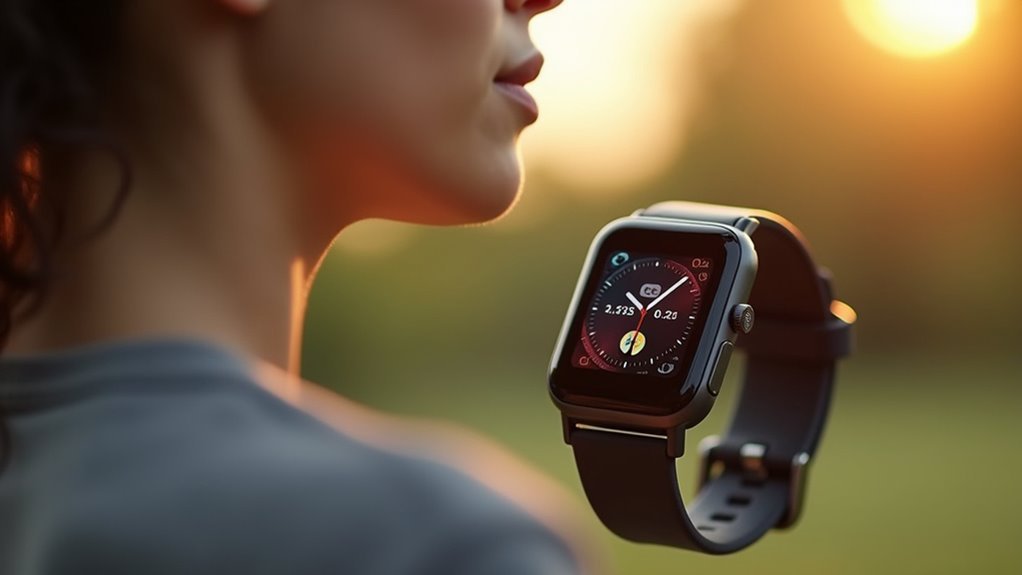
When stress strikes, fitness watches immediately capture the physiological changes happening in your body through sophisticated sensor arrays that monitor your heart rate and heart rate variability in real time.
This continuous monitoring system processes your physiological data instantly, enabling immediate detection of stress onset or recovery phases.
Your watch’s multi-sensor integration enhances accuracy by combining various biomarkers:
- Heart rate variability tracking – Measures autonomic nervous system activity reflecting your stress levels promptly
- Skin conductance monitoring – Detects galvanic skin response changes that complement heart rate metrics for thorough stress assessment
- Temperature and respiration analysis – Provides additional context to distinguish stress-induced changes from physical activity variations
The low-latency processing allows your device to compare current readings against your personalized baseline, triggering immediate alerts when significant stress responses occur. These sophisticated algorithms work continuously to interpret stress data patterns and provide meaningful insights into your body’s stress response mechanisms.
Algorithm Processing and Personalized Stress Score Generation
Multiple sophisticated algorithms work together to transform your raw physiological data into meaningful stress insights that reflect your unique biological patterns.
Your watch establishes a personal baseline by analyzing your heart rate variability over days to weeks, creating individualized physiological norms. When stress occurs, algorithms detect deviations from this baseline while filtering out physical activity using accelerometer data to isolate genuine stress responses.
The system generates dynamic stress scores—typically ranging from 0-3—based on your current HRV compared to your personal baseline. These scores provide real-time feedback that enables immediate awareness of your physiological state and stress levels.
Machine learning continuously adapts these algorithms, recognizing your recurring stress patterns and refining accuracy over time. Historical data integration helps calibrate present scores, while context-aware adjustments prevent misattributing natural physiological changes during exercise or sleep to stress.
Sleep Pattern Analysis and Its Impact on Recovery Assessment
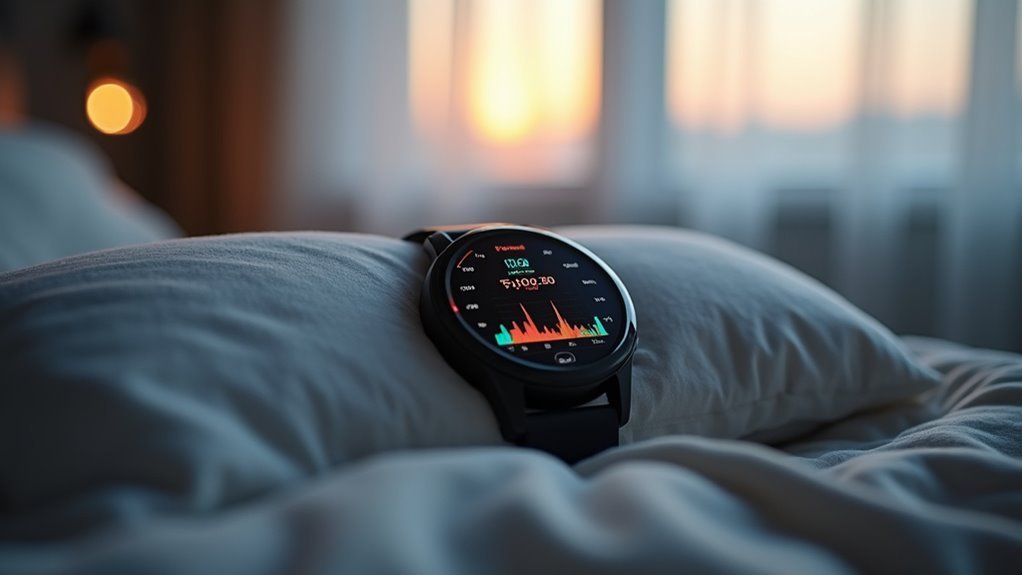
Your fitness watch doesn’t just count sheep—it analyzes how well you’re actually sleeping and what that means for your body’s recovery from stress.
The device tracks specific sleep quality metrics like heart rate variability, movement patterns, and breathing irregularities to determine whether you’re getting the restorative deep sleep and REM stages your stressed system desperately needs. Modern sleep trackers use algorithms that are comparable to polysomnography tests, providing clinical-grade accuracy in measuring your sleep stages throughout the night.
This sleep data then correlates directly with your stress levels, creating a clearer picture of whether last night’s rest truly prepared you for today’s challenges.
Sleep Quality Metrics
Sleep quality metrics represent the foundation of how your fitness watch evaluates recovery, yet the accuracy of these measurements varies considerably across different devices and sleep stages.
Your device doesn’t directly measure sleep but relies on indirect signals like movement and heart rate to estimate sleep patterns, creating inherent limitations in tracking accuracy.
Different devices show varying performance levels when compared to polysomnography, the gold standard for sleep assessment:
- Fitbit devices achieve 86.5% to 88% overall accuracy but struggle with REM sleep detection at 74%
- Oura Ring demonstrates 76.0% to 79.5% sensitivity for sleep stages with notable bias in sleep latency
- Apple Watch shows mixed results across different sleep stages with proportional bias in sleep efficiency
These metrics directly impact your recovery assessments since poor sleep quality correlates strongly with elevated stress levels. Consumer sleep trackers often overestimate total sleep time because they excel at detecting sleep but have difficulty accurately identifying wake periods throughout the night.
Recovery Sleep Stages
While overall sleep duration provides valuable insights, the specific stages your watch detects—REM, light, and deep sleep—determine how accurately it can assess your recovery potential.
Different devices show varying performance in stage detection. Fitbit Sense 2 overestimates light sleep while underestimating deep sleep, whereas airborne devices like SleepRoutine excel at wake and REM detection. Your watch’s ability to track sleep stage changes provides vital recovery insights, as REM and deep sleep are essential for physical and mental restoration.
However, you’ll encounter technological limitations compared to polysomnography, the gold standard. Devices face sensitivity-specificity trade-offs, with some detecting more sleep time while others better identify wakefulness. Most fitness watches estimate sleep patterns based on movement inactivity rather than directly measuring brain wave activity like medical sleep studies.
Despite these challenges, accurate stage analysis enables personalized recovery recommendations and helps optimize your performance strategies.
Stress-Sleep Data Correlation
Beyond accurately identifying sleep stages, fitness watches excel when they correlate your sleep patterns with stress recovery metrics to paint a thorough picture of your physiological state.
Your device analyzes sleep fragmentation, awakenings, and duration alongside heart rate variability to predict your recovery state with remarkable precision.
When you experience disrupted sleep from factors like alcohol consumption, your watch detects worsened HRV and elevated stress markers the following day. This correlation enables dynamic adjustments to your recovery recommendations.
Key correlation factors include:
- Sleep consistency patterns – Uninterrupted sleep correlates with lower stress scores and improved recovery metrics
- Nocturnal HRV fluctuations – Higher variability during sleep indicates better autonomic nervous system restoration
- Multi-sensor data fusion – Combining motion, temperature, and heart rate data enhances stress-sleep correlation accuracy
This thorough analysis helps differentiate between physical fatigue and psychological stress. However, it’s important to remember that these sleep metrics are estimates and should be used as general guidance rather than precise medical measurements.
Physical Activity Differentiation From Stress-Induced Changes
Since fitness watches monitor both stress levels and physical activity, they must accurately distinguish between stress-induced physiological changes and those caused by exercise.
Your device primarily uses Heart Rate Variability (HRV) to detect stress—lower HRV indicates higher stress levels. However, physical activity also affects HRV patterns, creating potential confusion.
Heart Rate Variability serves as the primary stress indicator, but exercise creates similar HRV patterns that can confuse detection algorithms.
Your watch’s accelerometer plays an essential role in this differentiation. When motion sensors detect high movement, the device adjusts or pauses stress calculations to avoid mislabeling exercise as stress.
Exercise typically causes temporary HRV reductions, but recovery shows increased variability, distinguishing it from chronic stress patterns.
Different brands use proprietary algorithms with varying sensitivity levels. Advanced devices combine multiple biosignals and use machine learning to improve accuracy over time, learning your specific stress and activity patterns. Users often find that these metrics quantify feelings of fatigue and stress that they already sense subjectively.
Mobile App Integration for Comprehensive Recovery Tracking
When your fitness watch collects stress and recovery data, the real power emerges through mobile app integration that transforms raw biometrics into actionable insights. Your watch continuously syncs heart rate variability, sleep stages, and activity levels to create personalized stress and recovery scores tailored to your lifestyle.
Mobile apps excel at thorough analysis by combining multiple data sources:
- Sleep Quality Assessment – Apps analyze light, deep, and REM phases with precision, correlating restorative patterns with HRV metrics for recovery evaluation.
- Holistic Recovery Scoring – Advanced features like Garmin’s Body Battery synthesize heart rate, respiration, and autonomic markers into user-friendly metrics.
- Personalized Coaching – Machine learning algorithms refine recommendations based on your individual patterns, menstrual cycles, and contextual factors.
You’ll receive real-time alerts and longitudinal feedback that guide informed decisions about training intensity and recovery needs. However, users often report that daily metrics can feel inconsistent with their personal sense of readiness, as algorithm-based tracking may introduce inaccuracies that don’t always align with how you actually feel.
Accuracy Challenges and Brand-Specific Algorithm Variations
The sophisticated insights from your fitness watch’s mobile integration rely on underlying sensors and algorithms that face significant accuracy challenges.
Your watch’s optical sensors vary in precision between brands, affecting HRV and stress measurements. Poor skin contact from loose wear or movement introduces errors, while physical activity creates motion artifacts that skew readings.
Each manufacturer uses proprietary algorithms to calculate stress and recovery, creating inconsistencies when you compare devices or switch brands.
What registers as high stress on one watch might show differently on another, even measuring the same physiological state.
These algorithm differences stem from each brand’s unique approach to processing HRV data—some use only heart rate variability, while others incorporate sleep, activity, and contextual information for more thorough stress calculations. Advanced devices now include readiness metrics that combine sleep quality, body temperature, and heart rate variability to provide more comprehensive recovery assessments.
Benefits of Continuous Stress Monitoring for Athletic Performance
Although accuracy challenges exist across different fitness watch brands, continuous stress monitoring offers compelling advantages for athletic performance that extend far beyond basic heart rate tracking.
You’ll discover that monitoring your stress levels enables better recovery management and workload enhancement, preventing overtraining while maintaining peak performance readiness.
When you’re consistently tracking stress, you’ll make better game-time decisions since excessive stress impairs cognitive function. Your coaches can adjust training loads based on your psychological and physical state, creating personalized programs that maximize results. Understanding these lifestyle stressors helps maintain optimal health and prevents chronic stress from undermining your competitive edge.
Key benefits include:
- Injury Prevention: Reduces overtraining risks by maintaining ideal stress thresholds
- Enhanced Recovery: Implements targeted recovery strategies based on real-time stress data
- Performance Optimization: Enables data-driven training periodization for sustained excellence
This objective assessment transforms how you approach training and competition preparation.
Future Innovations in Wearable Stress Recovery Technology
As fitness tracking technology evolves rapidly, you’ll soon experience revolutionary advances that’ll transform how your wearable devices monitor and enhance stress recovery.
Future wearables will integrate AI-powered health monitoring with real-time biomarker tracking, including glucose levels that directly impact your stress response. You’ll benefit from advanced biometric sensors monitoring ECG and heart rate variability with unprecedented precision.
These devices will seamlessly connect to your smart home systems, creating extensive health ecosystems that optimize your recovery environment.
Enhanced sleep tracking technology will provide deeper insights into your recovery patterns, while gesture control features will improve device interaction. These insights will enable instant dietary adjustments based on your body’s real-time stress and recovery needs.
Virtual reality integration will offer immersive stress recovery experiences, and early illness detection capabilities will identify stress-related conditions before they impact your performance.
Frequently Asked Questions
Can Fitness Watches Monitor Stress Recovery for People With Heart Conditions?
You can use fitness watches to monitor stress recovery with heart conditions, but you’ll need medical guidance since accuracy varies and your individual health factors affect the device’s reliability.
How Long Should I Wear My Fitness Watch for Accurate Stress Data?
You should wear your fitness watch continuously for at least several weeks to establish accurate stress data. Consistent wear helps create a reliable baseline for HRV measurements and improves algorithmic adaptation.
Do Fitness Watches Work for Stress Monitoring During Pregnancy or Menopause?
Fitness watches aren’t fully accurate for stress monitoring during pregnancy or menopause. Hormonal changes affect your heart rate variability, which can confuse algorithms designed for general populations, leading to unreliable stress readings.
Can Medications Affect My Fitness Watch’s Stress Recovery Measurements?
Yes, medications can affect your fitness watch’s stress recovery measurements. Drugs that influence heart rate or heart rate variability will skew HRV-based stress readings, though research on this topic remains limited.
What’s the Ideal Price Range for Accurate Stress Monitoring Fitness Watches?
You’ll get the most accurate stress monitoring in the $150–$300 mid-range segment, which offers improved HRV tracking and personalized insights without paying premium prices for features you might not need.
In Summary
You’re now equipped with a deeper understanding of how fitness watches monitor your stress recovery through sophisticated heart rate variability analysis and advanced sensor technology. You’ll benefit most when you consistently wear your device and allow its algorithms to learn your unique patterns. Don’t expect perfection—accuracy varies between brands—but you’ll gain valuable insights into your body’s recovery processes that’ll help optimize your training and overall wellness journey.

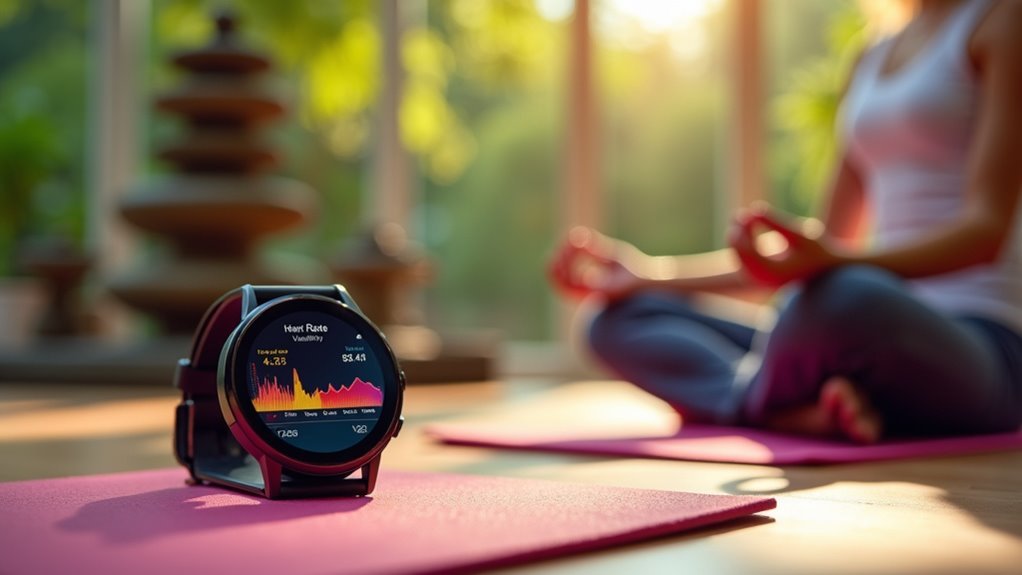
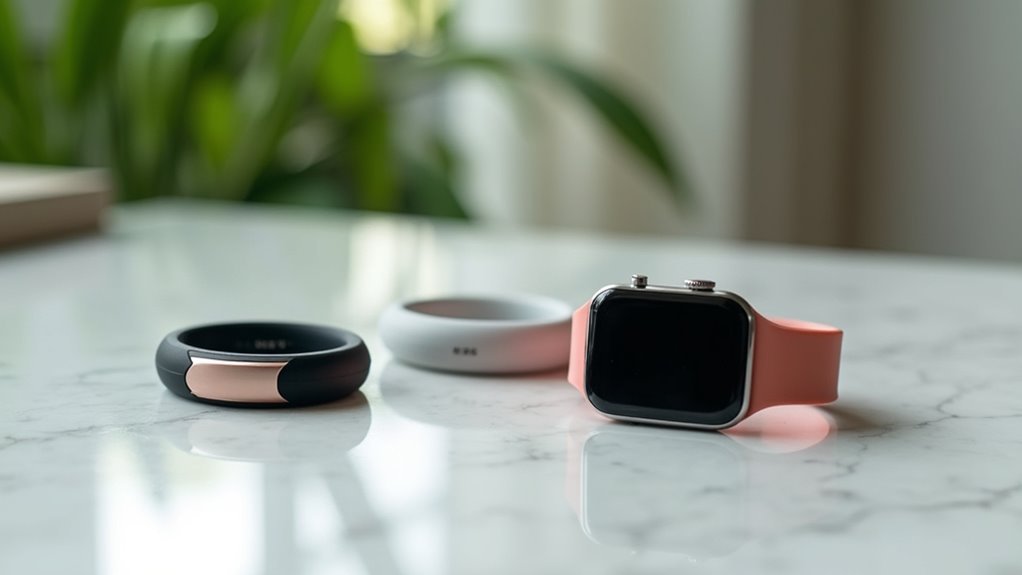
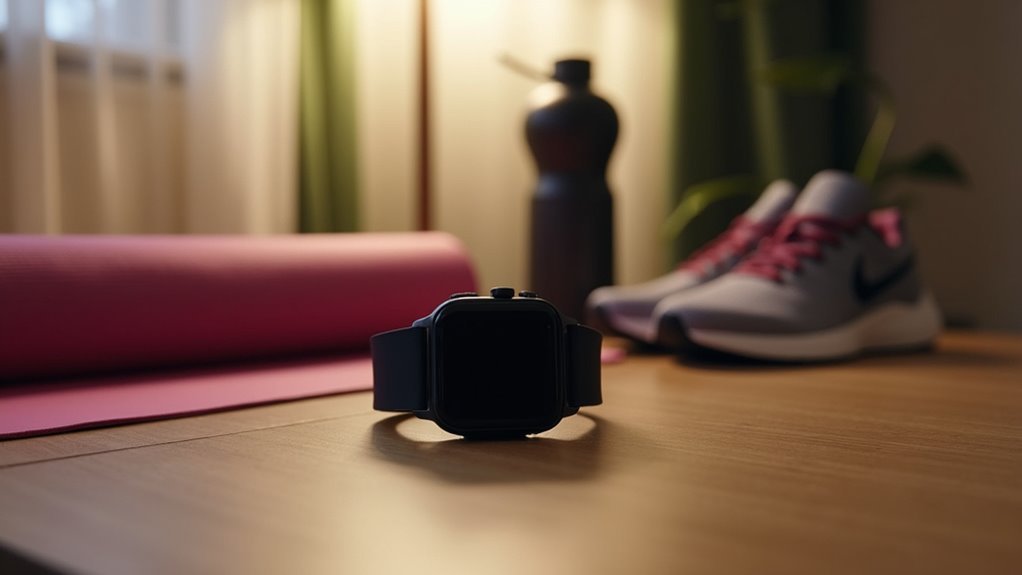
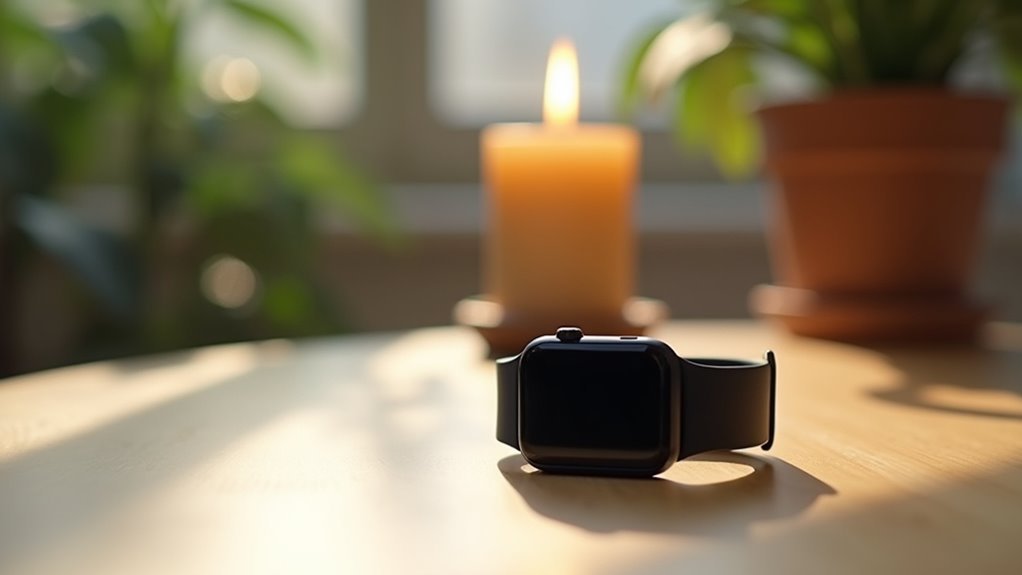
Leave a Reply